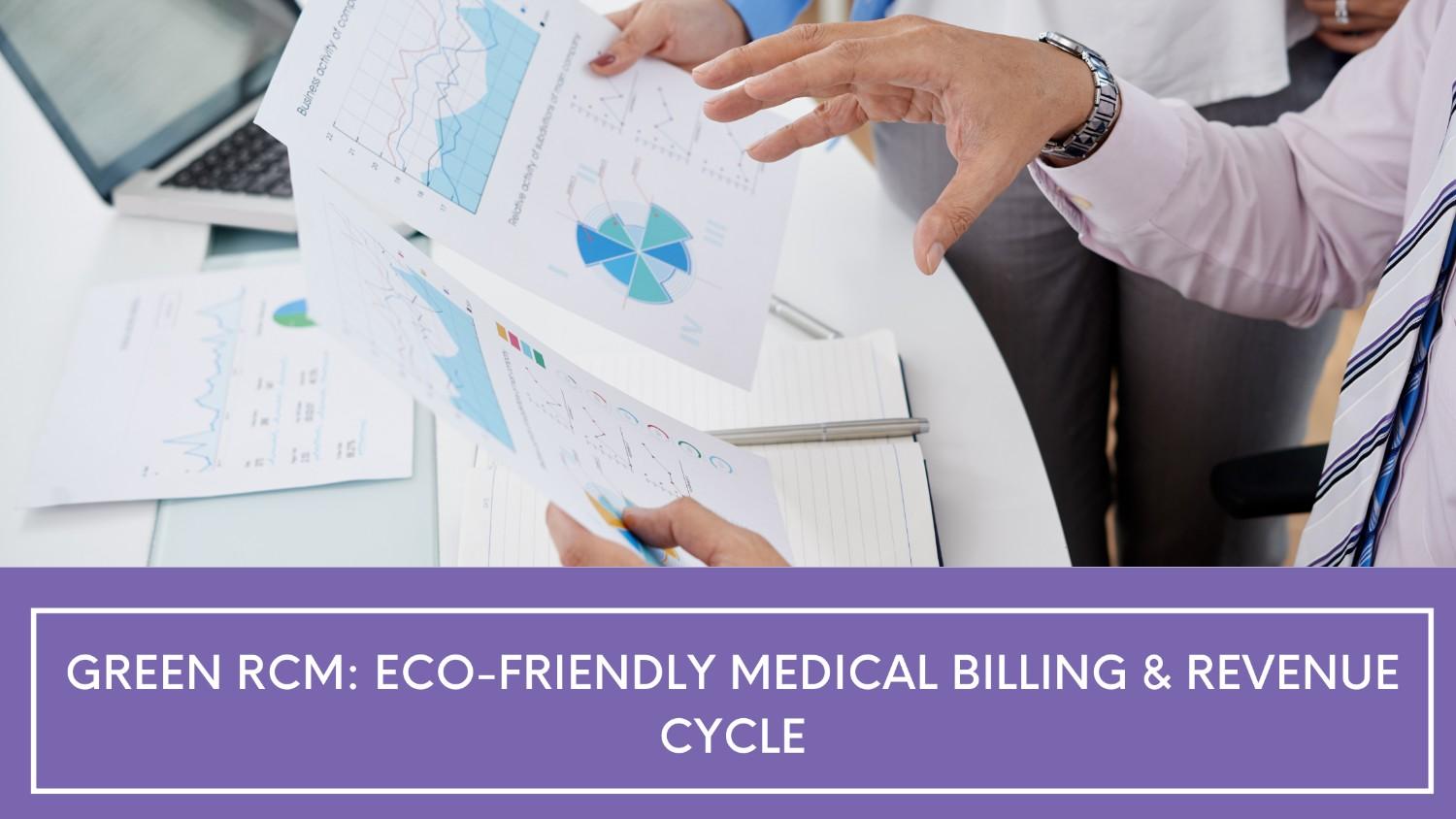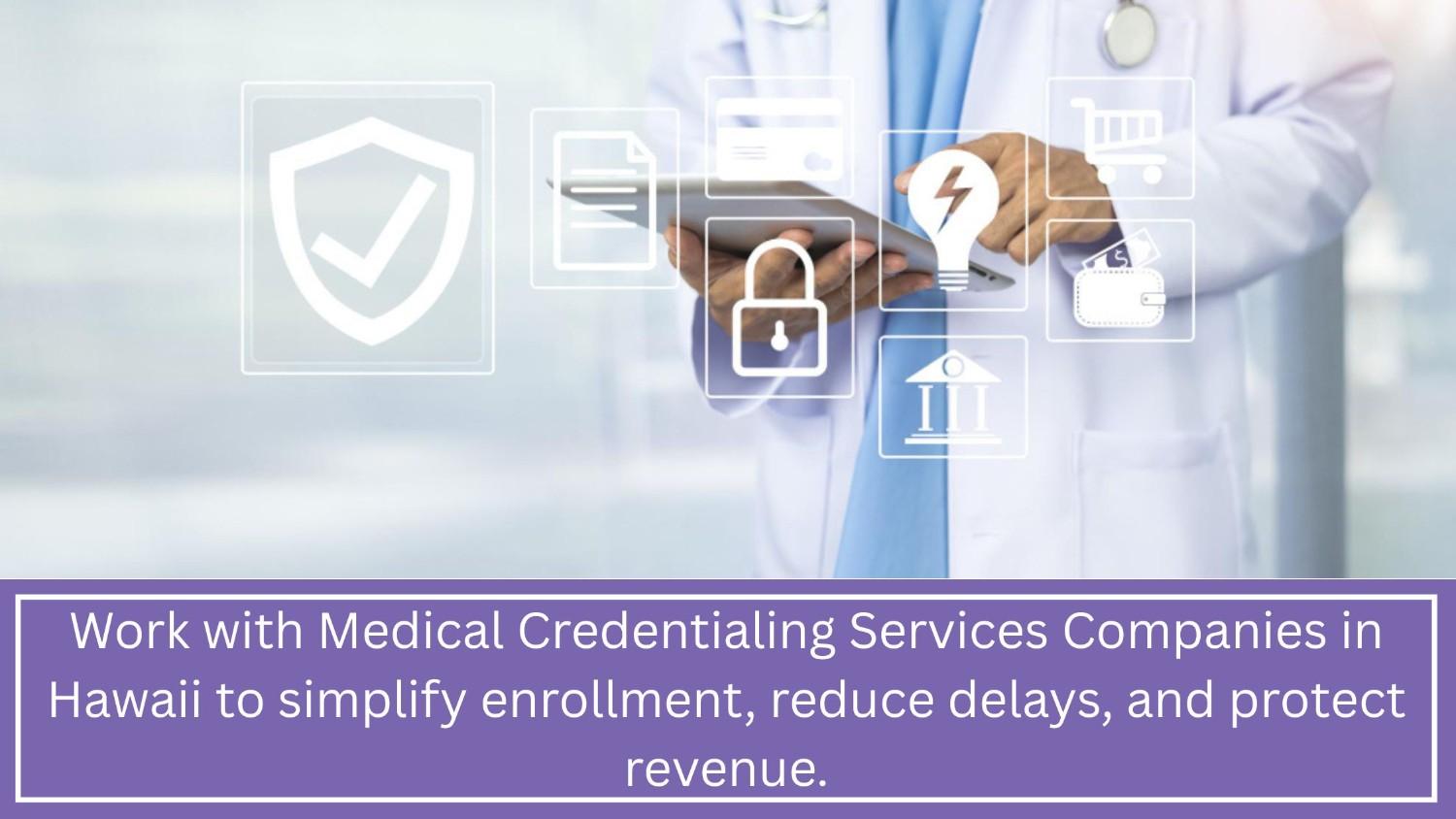Green RCM Sustainable Practices in Medical Billing and Revenue Cycle Management
In an era where sustainability is a growing priority, industries are rethinking their practices to align with environmental goals, and healthcare is no exception. The sector’s substantial carbon footprint, stemming from energy consumption, waste generation, and resource-heavy operations, calls for innovative approaches. While much focus has been on clinical and operational areas, the back-end processes like medical billing and revenue cycle management (RCM) are increasingly scrutinized for their environmental impact. Enter “Green RCM”—a strategy that combines efficient financial management with sustainability principles to transform healthcare operations.
Green RCM isn’t just about reducing paper use; it’s a comprehensive strategy that involves leveraging technology, optimizing workflows, and promoting a culture of environmental responsibility. For healthcare providers and RCM companies, adopting these practices is not only about corporate social responsibility but also about enhancing efficiency and reducing costs. As we dive into the components of Green RCM, we’ll explore how sustainable practices can transform the healthcare revenue cycle, leading to a more responsible and resilient industry.
Table of Contents
The Environmental Impact of Traditional RCM
To understand the significance of Green RCM, it’s crucial to first grasp the environmental toll of traditional RCM practices. The healthcare industry, particularly in the United States, is a major contributor to carbon emissions and waste generation. This impact extends beyond the clinical environment, with back-office operations playing a significant role.
- Paper Consumption: The healthcare industry is notorious for its reliance on paper. From patient records and billing statements to insurance claims and EOBs (Explanation of Benefits), the amount of paper used in traditional RCM is staggering. According to estimates, the average healthcare provider uses tens of thousands of sheets of paper annually, much of which ends up in landfills, contributing to deforestation and waste management issues.
- Energy Use: RCM processes involve the use of various electronic systems, from medical billing software to data storage solutions. Many of these systems are run on energy-intensive servers that contribute to a healthcare facility’s overall carbon footprint. Additionally, traditional billing often requires extensive manual data entry, which means longer working hours and, consequently, higher energy consumption.
- Waste Generation: Beyond paper waste, RCM processes generate a considerable amount of electronic waste (e-waste). Outdated computers, printers, and other electronic devices often end up discarded improperly, leading to hazardous waste problems.
- Logistical Emissions: The traditional revenue cycle often involves extensive physical transportation of documents between healthcare providers, payers, and patients. This transportation, often relying on courier services or postal mail, contributes to the carbon emissions associated with logistics.
Leveraging Technology for Sustainable RCM
At the heart of Green RCM is the strategic use of technology. By adopting digital solutions, healthcare organizations can significantly reduce their environmental impact while also improving efficiency. Here’s how technology can drive sustainability in medical billing and RCM:
- Electronic Health Records (EHR) and Electronic Billing: The transition from paper to electronic health records has been one of the most significant advancements in reducing paper usage. Electronic Health Record EHRs not only streamline patient information management but also facilitate electronic billing. By moving to e-billing, healthcare providers can eliminate the need for paper statements and claims, thus reducing paper consumption and associated waste.
- Cloud-Based Solutions: Traditional RCM systems often require on-premise servers that consume a significant amount of energy. Cloud-based RCM solutions, on the other hand, are hosted on remote servers managed by third-party providers who often implement energy-efficient practices. By shifting to cloud-based RCM, healthcare organizations can reduce their energy use and minimize their carbon footprint.
- Automation and AI: Incorporating automation and artificial intelligence into RCM processes can drastically cut down on manual tasks, leading to reduced energy consumption. For example, automated coding and billing systems can process claims faster and more accurately, reducing the need for manual intervention. This not only speeds up the revenue cycle but also decreases the energy required to power these processes.
- Telemedicine and Remote Billing: The rise of telemedicine has not only improved patient access to care but has also created opportunities for greener RCM practices. Remote billing, facilitated by telemedicine platforms, reduces the need for physical paperwork and in-person visits, thereby lowering emissions associated with travel and document transportation.
- E-signatures and Digital Authorizations: Implementing e-signature technology and digital authorizations can eliminate the need for printed consent forms and contracts. This not only reduces paper use but also accelerates the billing process, contributing to a more efficient and sustainable RCM workflow.
Workflow Optimization for Sustainable RCM
Technology alone is not enough; it must be paired with optimized workflows to realize the full benefits of Green RCM. Streamlining processes and eliminating inefficiencies can lead to significant environmental and financial gains. Here are some strategies for optimizing RCM workflows in a sustainable way:
- Lean Management Principles: Applying lean management principles to RCM can help identify and eliminate wasteful practices. For instance, analyzing the revenue cycle for redundant steps, unnecessary paperwork, and bottlenecks can lead to more streamlined operations, reducing resource use and improving efficiency.
- Remote Work and Telecommuting: Encouraging remote work for RCM staff can reduce the environmental impact of commuting. By allowing billers, coders, and administrative staff to work from home, healthcare organizations can decrease their carbon footprint and energy consumption associated with office space.
- Paperless Office Initiatives: While many organizations have moved to electronic records, there is often still a reliance on paper for certain tasks. A paperless office initiative can address this by promoting digital alternatives for all aspects of RCM, from internal communications to patient interactions.
- Sustainable Vendor Partnerships: Choosing vendors that prioritize sustainability can amplify the impact of Green RCM. For example, partnering with printing companies that use recycled materials and energy-efficient processes can reduce the environmental footprint of any remaining paper-based needs.
- Continuous Process Improvement: Implementing a culture of continuous improvement within RCM can help sustain green practices over the long term. Regularly reviewing and refining processes to incorporate the latest in sustainable practices ensures that RCM operations remain efficient and environmentally friendly.
Promoting a Culture of Sustainability in RCM
Achieving true sustainability in RCM requires more than just changes to technology and processes; it demands a shift in organizational culture. Building a culture of sustainability within the revenue cycle management team is crucial for long-term success. Here’s how healthcare organizations can foster such a culture:
- Education and Training: Providing ongoing education and training on sustainable practices is essential. RCM staff should be informed about the environmental impact of their work and trained in green practices such as digital billing, waste reduction, and energy conservation.
- Leadership Commitment: Sustainability initiatives are most successful when they are championed by leadership. RCM leaders should set an example by prioritizing green practices in their own work and making sustainability a key part of the department’s strategic goals.
- Employee Engagement: Engaging employees in sustainability initiatives can foster a sense of ownership and commitment. This could involve creating green teams within the RCM department, encouraging staff to contribute ideas for sustainability, and recognizing those who excel in promoting green practices.
- Sustainability Metrics and Reporting: To track progress and maintain momentum, organizations should establish metrics for sustainability within RCM. This could include tracking paper usage, energy consumption, and waste generation. Regularly reporting on these metrics helps maintain accountability and highlights the impact of green initiatives.
- Patient and Payer Collaboration: Extending the culture of sustainability beyond the organization involves collaboration with patients and payers. Educating patients about the benefits of electronic billing and encouraging payers to adopt green practices can create a more sustainable revenue cycle ecosystem.
The Financial Benefits of Green RCM
While the primary motivation for Green RCM is environmental sustainability, it’s important to recognize the financial benefits that come with it. Sustainable practices often lead to cost savings, making Green RCM a win-win for both the environment and the bottom line.
- Reduced Operational Costs: By transitioning to digital processes, healthcare organizations can significantly reduce the costs associated with paper, printing, and postage. Additionally, energy savings from cloud-based solutions and optimized workflows can lower utility bills.
- Efficiency Gains: Automation and workflow optimization not only reduce the environmental impact but also improve the speed and accuracy of RCM processes. Faster claim processing and fewer errors lead to quicker reimbursements and improved cash flow.
- Regulatory Incentives: In some regions, governments and regulatory bodies offer incentives for adopting green practices. These can include tax breaks, grants, or recognition programs that can provide financial benefits to organizations that implement sustainable RCM practices.
- Enhanced Reputation and Patient Loyalty: As patients become more environmentally conscious, they are likely to favor healthcare providers that demonstrate a commitment to sustainability. Green RCM can enhance an organization’s reputation and attract environmentally conscious patients, leading to increased patient loyalty and retention.
- Risk Mitigation: By adopting sustainable practices, healthcare organizations can mitigate risks associated with regulatory changes and resource scarcity. As governments and industries push for stricter environmental regulations, organizations that have already embraced green practices will be better positioned to comply and avoid potential fines or penalties.
Overcoming Challenges in Implementing Green RCM
While the benefits of Green RCM are clear, implementing these practices can present challenges. Understanding and addressing these challenges is key to successfully transitioning to a more sustainable revenue cycle.
Initial Investment Costs: Transitioning to Green RCM often requires upfront investments in technology, training, and process changes. While these costs can be offset by long-term savings, they can be a barrier for organizations with limited budgets.
Solution : Start small by prioritizing low-cost initiatives that can generate immediate savings, such as reducing paper usage or optimizing energy consumption. Use these savings to fund larger sustainability projects.
Resistance to Change: Like any major organizational change, the shift to Green RCM may be met with resistance from staff who are accustomed to traditional practices.
Solution: Engage employees early in the process by communicating the benefits of Green RCM and involving them in decision-making. Provide training and support to help staff adapt to new processes and technologies.
Technology Integration: Integrating new technologies into existing RCM systems can be complex, especially if legacy systems are in use.
Solution: Work with technology vendors who have experience in the healthcare industry and can provide solutions tailored to your organization’s needs. Consider phased implementation to minimize disruptions.
Regulatory Compliance: Ensuring that new green practices comply with healthcare regulations, such as HIPAA, can be challenging.
Solution: Collaborate with compliance experts to ensure that all green initiatives meet regulatory requirements. Use technology solutions that prioritize security and compliance.
Measuring and Reporting Impact: Quantifying the environmental and financial impact of Green RCM initiatives can be difficult, particularly in the early stages.
Solution: Establish clear metrics and baselines at the outset. Use software tools that can track and report on key performance indicators (KPIs) related to sustainability, such as paper usage, energy consumption, and cost savings.
The Future of Green RCM: A Path Forward
As the healthcare industry continues to evolve, the integration of sustainable practices into RCM will become increasingly important. The future of Green RCM will likely be shaped by several key trends:
- Advanced Technologies: The adoption of advanced technologies such as blockchain, machine learning, and predictive analytics will further enhance the efficiency and sustainability of RCM processes. These technologies can help reduce errors, streamline operations, and provide deeper insights into sustainability metrics.
- Stronger Regulations and Incentives: As governments and regulatory bodies place greater emphasis on environmental sustainability, healthcare organizations may face stricter regulations and more robust incentives to adopt green practices. This could accelerate the adoption of Green RCM.
- Patient-Centric Billing: As patients become more involved in their healthcare decisions, they will likely demand more sustainable billing practices. This could lead to a shift towards more transparent, digital, and eco-friendly billing processes that align with patient values.
- Global Collaboration: As healthcare becomes more interconnected globally, there will be opportunities for international collaboration on Green RCM initiatives. Sharing best practices and developing global standards for sustainable RCM could drive widespread adoption.
- Sustainability as a Competitive Advantage: As more healthcare organizations adopt Green RCM, sustainability will become a key differentiator in the marketplace. Organizations that lead in green practices will likely gain a competitive advantage, attracting environmentally conscious patients, payers, and partners.
In short, the transition to Green RCM represents a critical opportunity for healthcare organizations to align their financial management practices with broader environmental goals. By leveraging technology, optimizing workflows, and fostering a culture of sustainability, healthcare providers can reduce their environmental impact while also improving efficiency and reducing costs.
While challenges remain, the benefits of Green RCM from cost savings to enhanced reputation make it a worthwhile investment. As the healthcare industry continues to evolve, the integration of sustainable practices into revenue cycle management will not only contribute to a healthier planet but also to a more resilient and responsible healthcare system.
Embracing Green RCM is not just about doing what’s right for the environment; it’s about creating a sustainable future for healthcare. By making sustainability a core component of revenue cycle management, healthcare organizations can play a leading role in the global effort to reduce carbon emissions, conserve resources, and build a more sustainable world.
At Practolytics, we are committed to leading the way in revolutionizing healthcare revenue cycle management by seamlessly integrating advanced technologies with human expertise. Our approach ensures not only accuracy and efficiency but also a sustainable, forward-thinking strategy for financial operations. By making sustainability a core component of revenue cycle management, we aim to support healthcare organizations in reducing carbon emissions, conserving resources, and fostering a healthier planet.
Join us in this journey towards a more sustainable and efficient healthcare future. Contact Practolytics today to learn how we can help transform your RCM processes and support your organization’s sustainability goals.
ALSO READ – Unveiling Healthcare’s Financial Backbone: Medical Billing
Talk to Medical Billing Expert Today — Get a Free Demo Now!






